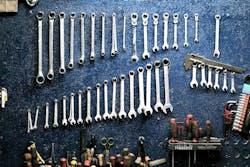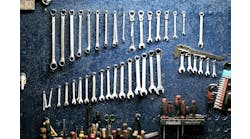Spectrophotometers may sound like something out of Ghostbusters, but there’s nothing supernatural about their real-world benefits to body shops.
Spectrophotometers—spectros, to the layperson—are color-matching devices used in science and industry. Invented by Arnold O. Beckman in 1940, spectro technology has certainly changed, but the basic concept remains the same: Light goes in. Data comes out.
Color data, that is.
Handheld spectros have been around a long time and more or less function the same—technicians use them to read vehicular colors and tones, and the spectro estimates the best options from a database, rating the colors to provide the closest match.
“The difference with this spectro is it not only does that,” Jeremy Foster says, manager of online business development for Automotive Art Paints, “it allows you to correct the formulation as close as humanly possible. It not only knows the formula database, it understands how the toners behave when mixed together; it knows the strength of the toner and allows you to adjust the formula for the closest match possible.”
Dereck Foster, Jeremy’s father and the founder of Automotive Art Paints, chips in.
“That’s the most fundamental difference between this technology and everything else on the market,” he says. “ADAM5 gives you the closest match possible.”
Now, let’s put that in context.
Old Problems and New Solutions
Painting a vehicle is not unlike painting a room—it’s often easier to coat an entire wall than to touch up a small portion. And, in the body shop world, it can be expensive.
“Body shops don’t want to respray,” Jeremy says. “They want to do it once, and then it’s done.”
It’s no secret that re-dos are costly. There’s the paint labor, P&M costs, lost opportunity of a new job, the cost to run the booth, as well as the loss of efficiency and, more than likely, the next job’s efficiency, to contend with. It easily adds up to thousands of dollars.
That doesn’t even count the time it takes to do sprayouts and the associated costs of lost paint materials.
In a previous FenderBender story, Premier Collision Center’s lead painter Steve Jones (who helped drop the Duluth, Ga., shop’s P&M bill by $5,000 per month to a gross profit of 55 percent), detailed just how much sprayouts and color matching weigh down the paint process.
“If I’m doing the sprayouts properly and checking my colors, I’m only painting cars one at a time,” he says. “Ninety-nine percent of your repaints are for color. If you’re repeating, that’s twice as much material you’re not getting paid for. That’s going to affect your bottom line, your efficiency, your paint and material numbers.”
The ADAM5, though, isn’t designed to just reduce sprayouts.
“It has the potential to eliminate sprayout completely, allowing shops to maximize their resources and become more efficient,” Dereck says.
Other spectrophotometers read colors and present you with the best match from your database. Fine—great. What the ADAM5 is capable of producing, however, is the ability to tweak the formulation and get as close to true color as possible. It has five cameras instead of the industry-standard three, and was designed in conjunction with Automotive Art’s Motomix Plus Color Software; together, the total system removes any guesswork in fewer steps with greater accuracy.
The five-camera breakthrough allows the ADAM5 to match any metallic, pearl, or xirallic with pinpoint accuracy.
“Take it one step further,” Dereck says. “Depending on the age of the car, and particularly with bright colors and UV damage, the material deteriorates. The spectro actually matches the deteriorated color.”
No more spraying Challenger Plum Purple on a 40-year-old Dodge whose purple has faded. No more false positive matches on the tops of the louvers on Dad’s 1968 Rally Red Corvette C3.
“The spectro is reading the faded color and will give you the best formula to mix that same color, so when you spray it on an older vehicle, you’re going to get the best possible match,” he says.
21st Century Connectivity and Power
The handheld ADAM5 functions like any other wireless app on your smartphone. It features a full-color touchscreen display, and Wi-Fi connectivity allows it to run anywhere in the world with a Wi-Fi connection, connecting instantly to Automotive Art’s Motomix Plus Color Software and database. The database is updated twice per day and wireless technology allows shop owners and technicians to send color formulas from the field back to their mixing rooms for increased efficiency. The ADAM5 is also equipped with a built-in memory that can store up to 30 readings, ensuring your shop keeps running—and the repaint and repair can continue—during Internet outages.
Motomix Plus also works in the cloud, allowing the software to function on any device—computers, tablets, mobile phones—in the office and on the shop floor, as well as remotely, from garages to crash sites, offering three distinct advantages:
First, the ADAM5 stores your custom formulas in the cloud, which allows them to be shared across mixing rooms within jobber stores and larger body shop networks. Next, Motomix Plus enables customers to have access to the most up-to-date formula database available without having to remember to update any software on their PCs. Finally, every reading from ADAM5 can be sent directly into Motomix Plus from the field, so jobber reps can take measurements in body shops and send their readings directly back to the store for mixing via Wi-Fi.
“You’re giving the body shop the ability to lay down the best possible match and avoid respraying or redoing any part of it,” Dereck says. “It will save money. It will allow body shops to perform their jobs faster, more efficiently, and produce better work for their clients.”
And though the spectro can’t help with spilled paint, it can manage flop. That’s the breakthrough of the five-camera system.
“That’s the difference,” Jeremy says. “It can look at the color from different angles and manage and understand the pigments that allow the 'flop' to occur.”
Dereck offers another example.
“Imagine matching someone’s eyes—imagine how hard that would be to do manually,” he says. “Shop owners, colorists, and technicians face the same challenge.
“The spectro will do what these highly technical and skilled people can do—it will augment their abilities,” he says. "What we’re doing now is giving the body shop the tools to ensure that, no matter what position they find themselves in, they have the opportunity to produce the best level of work for their customers. The Adam 5 will make highly skilled colorist even better by enhancing their skills and allowing them to produce the best color match possible the first time, every time."
Can it play music?
“No,” they both laugh, “we’ll save that for the ADAM6!”
The ADAM5 was a massive undertaking. It spent over two years in development, and works exclusively with Automotive Art’s paint database of over 150,000 colors and tones. It launched at AutoMechanika in Germany in September 2018, and saw its North American debut at the SEMA trade show in Las Vegas soon after. The ADAM5 was met with rave reviews.
“It’s smart,” Dereck says. “If you tell it the car manufacturer and color code that you’re scanning—say, a Honda—it will list that manufacturer’s colors first, along with the projected accuracy of the color match.”
But here’s the kicker:
“The software will then give you the option to select perhaps a different formula, from a different manufacturer that gives you a higher projected color match without any formula adjustment. So you may end up spraying your Honda with a Mercedes color, simply because it gives you a better match.”
In other words, the ADAM5 matches the color of the car, and not the manufacturer. It can match colors either using its standard formula database of known manufacturer’s codes, or organically develop formulas because the color correction algorithms intuitively understand how Automotive Art’s toners work in unison to produce the best possible match.
“You’re literally matching what’s in front of your eyes,” Dereck says.
The ADAM5 is available now. It comes with a proprietary license, as the spectro only works with the Automotive Art system.
“The ADAM5 is a testament to the type of people we’ve been able to attract and the talent we have in our organization,” Dereck says.
From humble beginnings as a jobber store in Barbados, Automotive Art Paints is now a global manufacturer of automotive refinish and products such as the groundbreaking spectrophotometer. The company employs about 450 people in the Caribbean Islands, another 150 in Poland, and several dozen in the United States.
“Any paint company will tell you the achievement we’ve made with the ADAM5 is a huge achievement,” Dereck says, “and what we’ve accomplished is nothing short of remarkable.”


